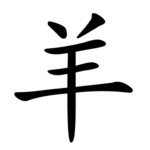Radical 123
Radical 123 or radical sheep (羊部) meaning "sheep" or "goat" is one of the 29 Kangxi radicals (214 radicals in total) composed of 6 strokes.
| 羊 | ||
|---|---|---|
| ||
| 羊 (U+7F8A) "sheep" | ||
| Pronunciations | ||
| Pinyin: | yáng | |
| Bopomofo: | ㄧㄤˊ | |
| Gwoyeu Romatzyh: | yang | |
| Wade–Giles: | yang2 | |
| Cantonese Yale: | yèuhng | |
| Jyutping: | joeng4 | |
| Japanese Kana: | ヨウ yō (on'yomi) ひつじ hitsuji (kun'yomi) | |
| Sino-Korean: | 양 yang | |
| Names | ||
| Chinese name(s): | (Left) 羊字旁 yángzìpáng (Top) 羊字頭/羊字头 yángzìtóu | |
| Japanese name(s): | 羊/ひつじ hitsuji (Left) 羊偏/ひつじへん hitsujihen | |
| Hangul: | 양 yang | |
| Stroke order animation | ||
 | ||
In the Kangxi Dictionary, there are 156 characters (out of 49,030) to be found under this radical.
羊 is also the 143rd indexing component in the Table of Indexing Chinese Character Components predominantly adopted by Simplified Chinese dictionaries published in mainland China, with ⺶ and 𦍌 being its associated indexing component.
Evolution
 Oracle bone script character
Oracle bone script character Bronze script character
Bronze script character Large seal script character
Large seal script character Small seal script character
Small seal script character
Derived characters
| Strokes | Characters |
|---|---|
| +0 | 羊 |
| +1 | 羋 |
| +2 | 羌 |
| +3 | 羍 美 羏 羐 (=羑) 羑 |
| +4 | 羒 羓 羔 羖 羗 (=羌/羑) 羘 羙 (=美 羔) |
| +5 | 着SC/HK (=著 -> 艸) 羕 羚 羛 羜 羝 羞 羟SC (=羥) |
| +6 | 羠 羡SC (=羨) 羢 (=絨 -> 糸) |
| +7 | 羣HK (=群) 群 羥 羦 羧 羨 義 羪 |
| +8 | 羫 |
| +9 | 羬 羭 羮 (=羹) 羯 羰 |
| +10 | 羱 羲 |
| +12 | 羳 羴 羵 |
| +13 | 羶 羷 羸 羹 |
| +14 | 羺 |
| +15 | 羻 羼 |
Sinogram
The radical is also used as an independent Chinese character. It is one of the Kyōiku kanji or Kanji taught in elementary school in Japan.[1] It is a third grade kanji[1]
References
- "The Kyoiku Kanji (教育漢字) - Kanshudo". www.kanshudo.com. Archived from the original on March 24, 2022. Retrieved 2023-05-06.
See also
Literature
- Fazzioli, Edoardo (1987). Chinese calligraphy : from pictograph to ideogram : the history of 214 essential Chinese/Japanese characters. calligraphy by Rebecca Hon Ko. New York: Abbeville Press. ISBN 0-89659-774-1.
This article is issued from Wikipedia. The text is licensed under Creative Commons - Attribution - Sharealike. Additional terms may apply for the media files.